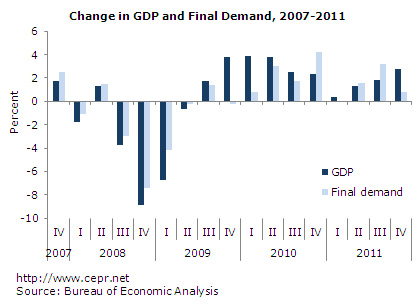January 27, 2012
January 27, 2012 (GDP Byte)
By Dean Baker
Final demand grew at just a 0.8 percent rate in the fourth quarter.

A sharp reversal from the third quarter’s decline in inventories added 1.94 percentage points to GDP growth in the fourth quarter, bringing the rate to 2.8 percent. Final demand grew at just a 0.8 percent rate in the quarter, a sharp drop from the 3.2 rate in the third quarter, as a 4.6 percent drop in government spending lopped almost a full percentage point off growth in the quarter.
The drop in government spending was mostly attributable to a 12.5 percent drop in defense spending. Non-defense spending at the federal level actually rose slightly in the quarter. State and local spending declined at a 2.6 annual rate, reducing growth by 0.32 percentage points. Federal as well as state and local spending are likely to continue to drift downward – although probably at a slower rate in future quarters. The drag on growth is more likely to be in the range of 0.2-0.4 percentage points.
Investment in equipment and software, which had grown at a 16.4 percent rate in the third quarter, slowed to a 5.2 percent rate in the fourth quarter. This is most likely just an issue of timing, with shipments showing up in the third quarter rather than the fourth. The underlying rate of growth in this sector is still in the 8-10 percent range.
Investment in non-residential structures fell by 7.2 percent after two quarters of strong growth. Spending in this category is still down by almost 30 percent from its boom levels before the recession. It is likely to grow modestly in the future quarters. Residential investment grew by 10.9 percent in the quarter. This rate will not be maintained (good weather helped), but the general path will be upwards.
Consumption grew at a 2.0 percent rate, driven by a 48.1 percent jump in car sales. This growth rate will not continue. However, on the other side there was a sharp drop in housing and utilities, presumably driven primarily by less utility use in a warm winter, which reduced GDP growth by 0.4 percentage points. Interestingly, health care spending only increased at a modest 1.1 percent annual rate after falling at a 0.6 percent rate in the third quarter. It is possible that we are finally seeing a slowdown in growth in this sector.
Trade subtracted 0.11 percentage points from growth, with a 4.4 percent rise in imports outweighing the impact of a 4.7 percent increase in exports, since the former is a much larger share of GDP. Given the sharp buildup in inventories, it is surprising that imports did not rise more; although both numbers will be subject to substantial revisions since the December data in both cases is simply imputed in this release.
Inflation fell sharply in all measures in the quarter. The overall deflator grew at just a 0.4 percent rate after growing at a 2.6-2.7 percent rate over the prior three quarters. Most of the decline reflected a drop in food and energy prices; however, the core index rose at just a 0.9 percent rate in the quarter. Clearly, there is no basis for concern about excessive inflation any time soon.
While the 2.8 percent growth is the strongest figure since the second quarter of 2010, it is not an especially rapid pace given the severity of the downturn. With GDP approximately 6 percentage points below its potential, assuming CBO’s potential growth rate of 2.5 percent, it would take close to 20 years to return to potential GDP at this pace.
There is not much prospect for a substantial pickup in the immediate future. Car buying will not continue to grow at such an extraordinary pace; although the decline in the housing and utility category also will not be repeated. However, with the saving rate already down to 3.7 percent, it is unlikely that consumption will outpace income growth in the quarters ahead, meaning that real consumption growth is likely to be near 2.0 percent. Equipment and software spending will continue to grow in an 8-10 percent range, with both residential and non-residential structures showing modest growth. With government spending still slowing growth by 0.2-0.4 percentage points, growth is likely to remain below 3.0 percent through 2012.






